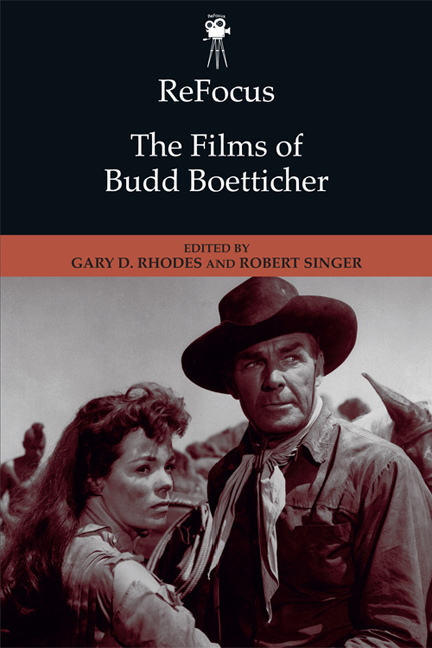Book contents
- Frontmatter
- Contents
- Notes on Contributors
- Dedication
- Introduction
- Part 1 The Non-Westerns
- Part 1 Introduction
- 1 “I never did think he was crazy”: Mystery and Criminality in Boetticher's Psychological Noirs
- 2 On Ethics and Style in Bullfighter and the Lady (1951)
- 3 Domestic Tension and Male Hysteria: The Killer is Loose (1956)
- 4 The Killer is Loose (1956) and the Televisual Dissolution of Film Noir
- 5 Adventures on the Small Screen: Boetticher, Warner Bros., and Maverick
- 6 The Signifying Heel: Boetticher's The Rise and Fall of Legs Diamond (1960)
- Part 2 The Westerns
- Index
4 - The Killer is Loose (1956) and the Televisual Dissolution of Film Noir
from Part 1 - The Non-Westerns
Published online by Cambridge University Press: 22 December 2017
- Frontmatter
- Contents
- Notes on Contributors
- Dedication
- Introduction
- Part 1 The Non-Westerns
- Part 1 Introduction
- 1 “I never did think he was crazy”: Mystery and Criminality in Boetticher's Psychological Noirs
- 2 On Ethics and Style in Bullfighter and the Lady (1951)
- 3 Domestic Tension and Male Hysteria: The Killer is Loose (1956)
- 4 The Killer is Loose (1956) and the Televisual Dissolution of Film Noir
- 5 Adventures on the Small Screen: Boetticher, Warner Bros., and Maverick
- 6 The Signifying Heel: Boetticher's The Rise and Fall of Legs Diamond (1960)
- Part 2 The Westerns
- Index
Summary
INTRODUCTION: A FOGGY NOTION
If one factor sets apart Budd Boetticher's 1956 film The Killer is Loose from the classic films noirs it both imitates and seeks to revise, it is the film's overt concern with televisuality. Not only does a television set appear prominently in the film's tense home-invasion scene, but the final duel between the police and Leon “Foggy” Poole (Wendell Corey) plays out as though the investigators were watching him on a television screen—distant and detached, but nonetheless clearly visible—as his attempt at revenge unfolds in simultaneous real time. The Killer is Loose should be understood as a revisionist film noir, one of a handful of late noirs that explicitly foreground televisuality as a kind of epistemological crisis. In the film, television is both a material technology and a way of seeing, with various scenarios conveying ambivalence about new technology while inviting viewers to grapple with the question of how much knowledge is too much. At the same time, the film can be understood as a generic capstone, a film that reflects back on classic noir and, in distinct ways, illuminates its obsession with the passing medium of newsprint, a longstanding cultural phenomenon whose appeal is rooted in delayed dissemination and readerly speculation as opposed to television's instantaneity and illusion of completeness.
Like numerous films noirs before it, The Killer is Loose provides a tantalizingly perverse inside view of a lone operator as he plans and executes a complex crime—one which the general public fails to discern as its happening. In this way, the film recapitulates an underappreciated, but deeply ingrained, intertextuality in the narratives of classic noir: the fetishization of one medium, newsprint, by another, cinema. It is precisely this popular fixation on the vagaries of newsprint culture that The Killer is Loose simultaneously honors and ushers out via its equally adamant invocation of the emerging technology of television. In this context, the film's antagonist—whose nearsightedness earns him the nickname “Foggy”—is a pure metaphor. Though Poole's sanity is called into question by various characters, the real issue is not whether Poole is psychotic. Instead, the primary question must be: what does his myopic view of the world represent? The answer is that “Foggy” Poole represents culture's increasing marginalization of isolating, opaque, non-televisual ways of seeing in the era of late noir.
- Type
- Chapter
- Information
- ReFocus: The Films of Budd Boetticher , pp. 55 - 74Publisher: Edinburgh University PressPrint publication year: 2017



